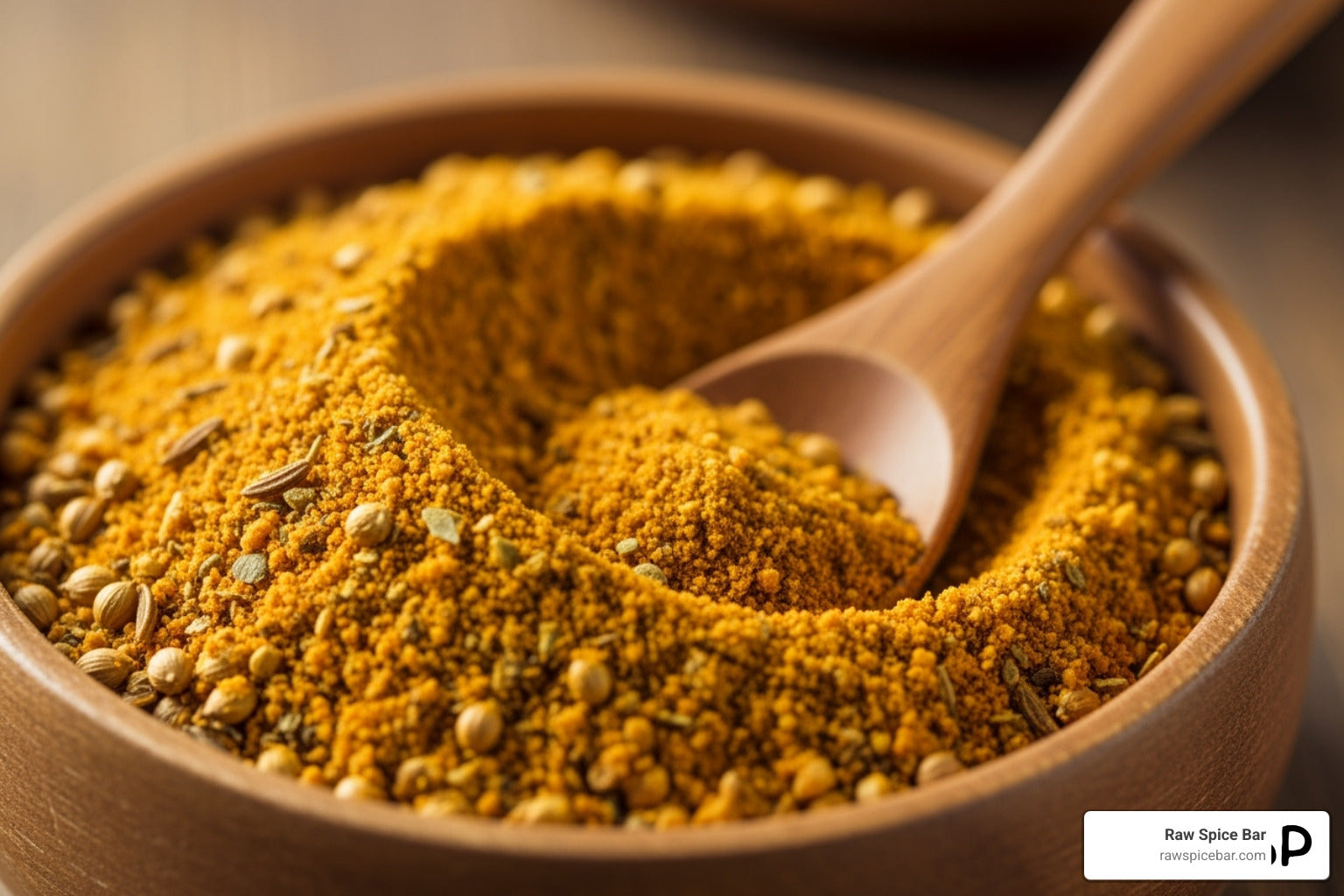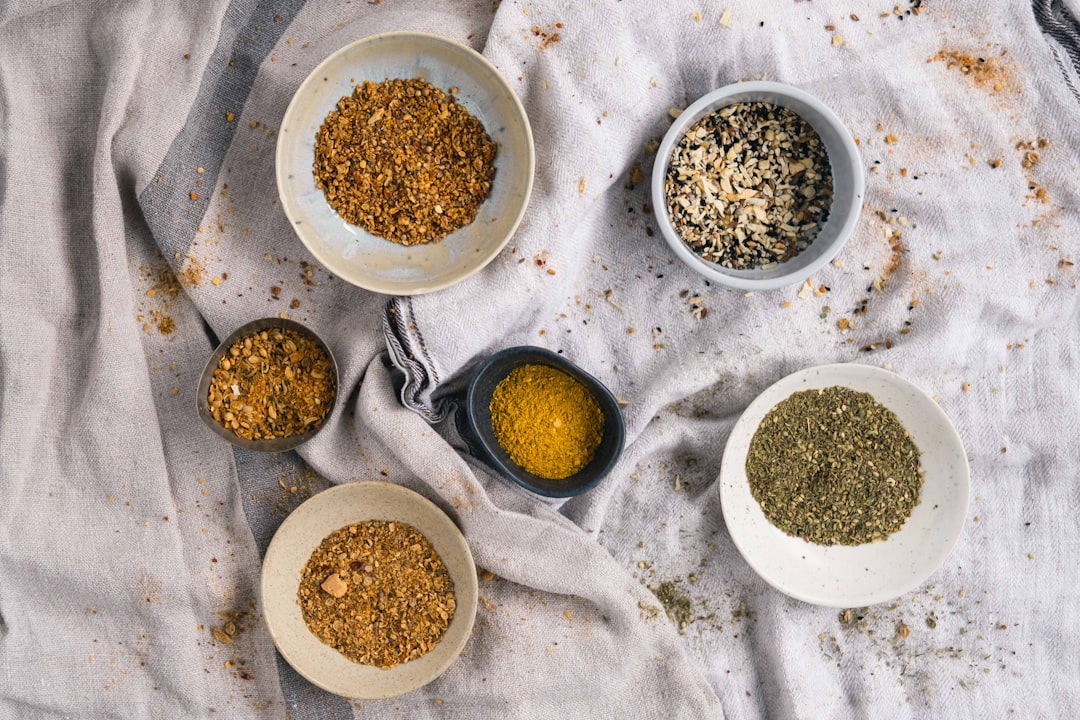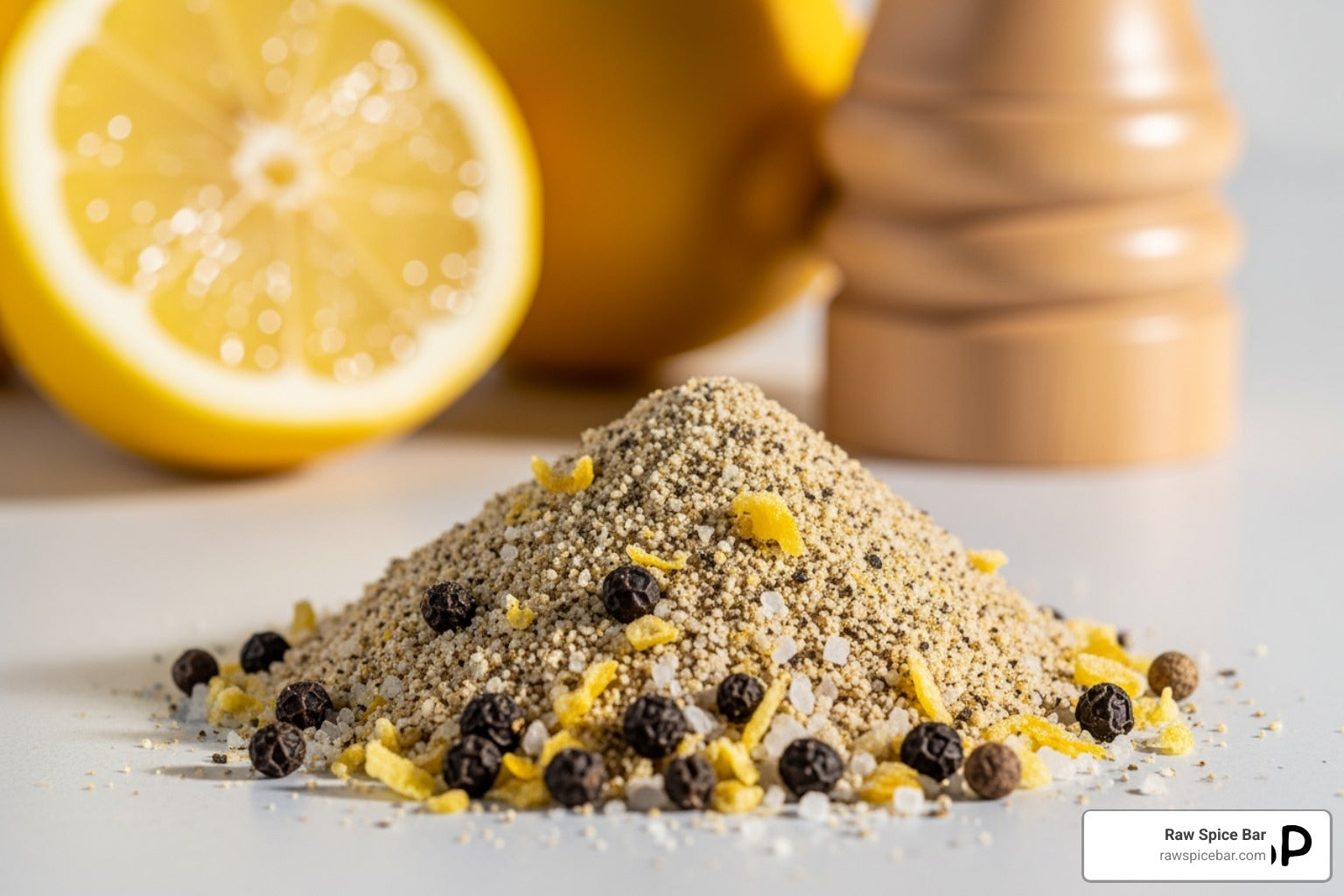The Secret to Unforgettable Fried Chicken: Proper Seasoning
For truly flavorful poultry seasoning for fried chicken, a rich blend of herbs and spices is essential. This typically includes:
- Aromatic Herbs: Dried sage, thyme, rosemary, and marjoram.
- Savory Foundation: Garlic powder and onion powder.
- Color and Mild Heat: Paprika.
- Essential Seasonings: Salt and black pepper.
- Tip: For the breading, use at least double the amount of spices you think you need to ensure maximum flavor sticks to your crispy crust.
Achieving the perfect crispy, juicy fried chicken goes beyond just frying—it starts with masterful seasoning. This guide will walk you through everything you need to know, from traditional poultry blends to global inspirations. You'll learn how to infuse flavor at every step, ensuring your fried chicken is unforgettable.
As the founder of a spice brand, I've spent years crafting premium blends. My expertise in developing the perfect poultry seasoning for fried chicken ensures every bite is packed with flavor. Let's explore mastering the art of fried chicken seasoning.

Common Poultry seasoning for fried chicken vocab:
What is Poultry Seasoning? The Ultimate Flavor Foundation
Ever wondered what gives holiday turkey its signature, comforting taste? It's poultry seasoning. This classic herb blend's versatile, savory profile is also an amazing flavor foundation for fried chicken. It's a common blend you can easily make at home.
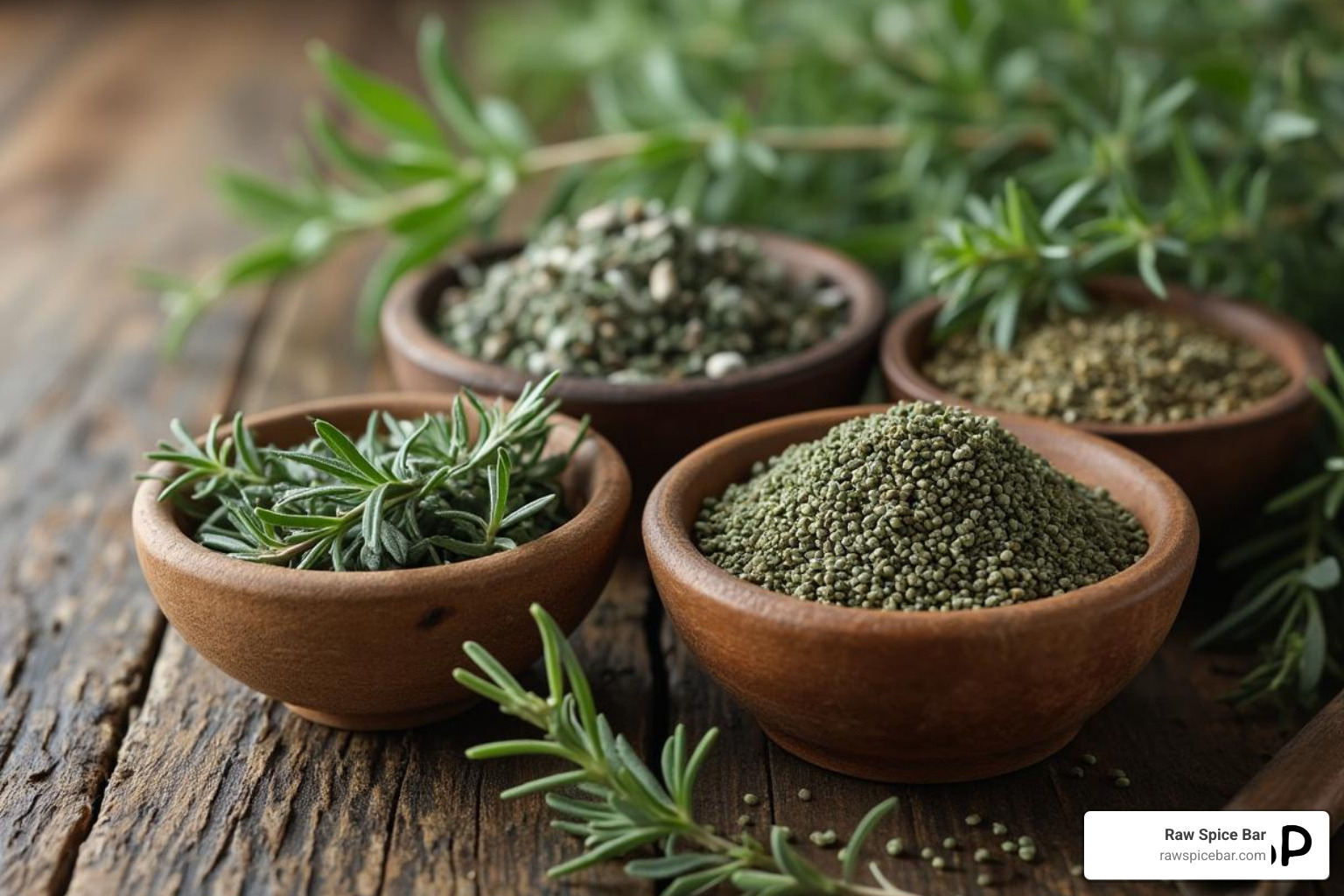
This aromatic mixture creates a warm, earthy, and slightly peppery flavor that sings with poultry. It's that comforting aroma of home-cooked goodness, and poultry seasoning for fried chicken brings that same warmth to your plate.
What's in a Typical Poultry Seasoning for Fried Chicken?
A typical poultry seasoning for fried chicken features a core group of dried herbs and spices that work together to deliver a rich, savory profile that stands up to frying.
This magical mix often includes Dried Sage for an earthy, peppery note; Dried Thyme for a subtle, floral touch; and Dried Marjoram for a milder, sweeter aroma. Dried Rosemary adds a distinctive, piney kick.
For depth, a bit of Ground Nutmeg adds warmth, while Finely Ground Black Pepper provides a classic bite. Many blends also feature Onion Powder and Garlic Powder for a savory foundation. Paprika is often added for color and mild flavor. While salt is usually added separately, some blends might include it.
Understanding these components helps us appreciate the intricate flavor balance poultry seasoning for fried chicken brings. Looking to dive deeper? Check out What Are Spice Blends?.
How Does Poultry Seasoning Affect Fried Chicken?
Using poultry seasoning for fried chicken does more than just add flavor; it infuses the meat and contributes to the entire fried chicken experience.
Flavor Infusion: The seasoning's main job is to give the chicken a rich, savory, and aromatic flavor. When applied directly to the meat, the spices penetrate, ensuring every bite is seasoned through.
Crust Development: The spices become embedded in the flour coating. As the chicken fries, these spices caramelize, forming a flavorful, crunchy shell. For ultimate crispiness, add cornstarch to your dredge.
Moisture Retention: While the blend itself doesn't add moisture, applying it via a brine (wet or dry) helps the meat absorb both moisture and flavor, keeping it juicy.
Balanced Flavor: A well-crafted poultry seasoning for fried chicken ensures a complex taste, preventing the chicken from being bland.
You might hear about Monosodium Glutamate (MSG) in fried chicken seasoning. MSG is a popular flavor improver that boosts savory and umami notes. While some report sensitivities, major food regulatory bodies like the FDA consider MSG safe for consumption. To learn more, check out More on the role of MSG in flavor.
The Art of Seasoning: How to Use Poultry Seasoning for Fried Chicken
Here's where the magic happens. The secret to flavor-packed fried chicken is building layers of flavor at every step.
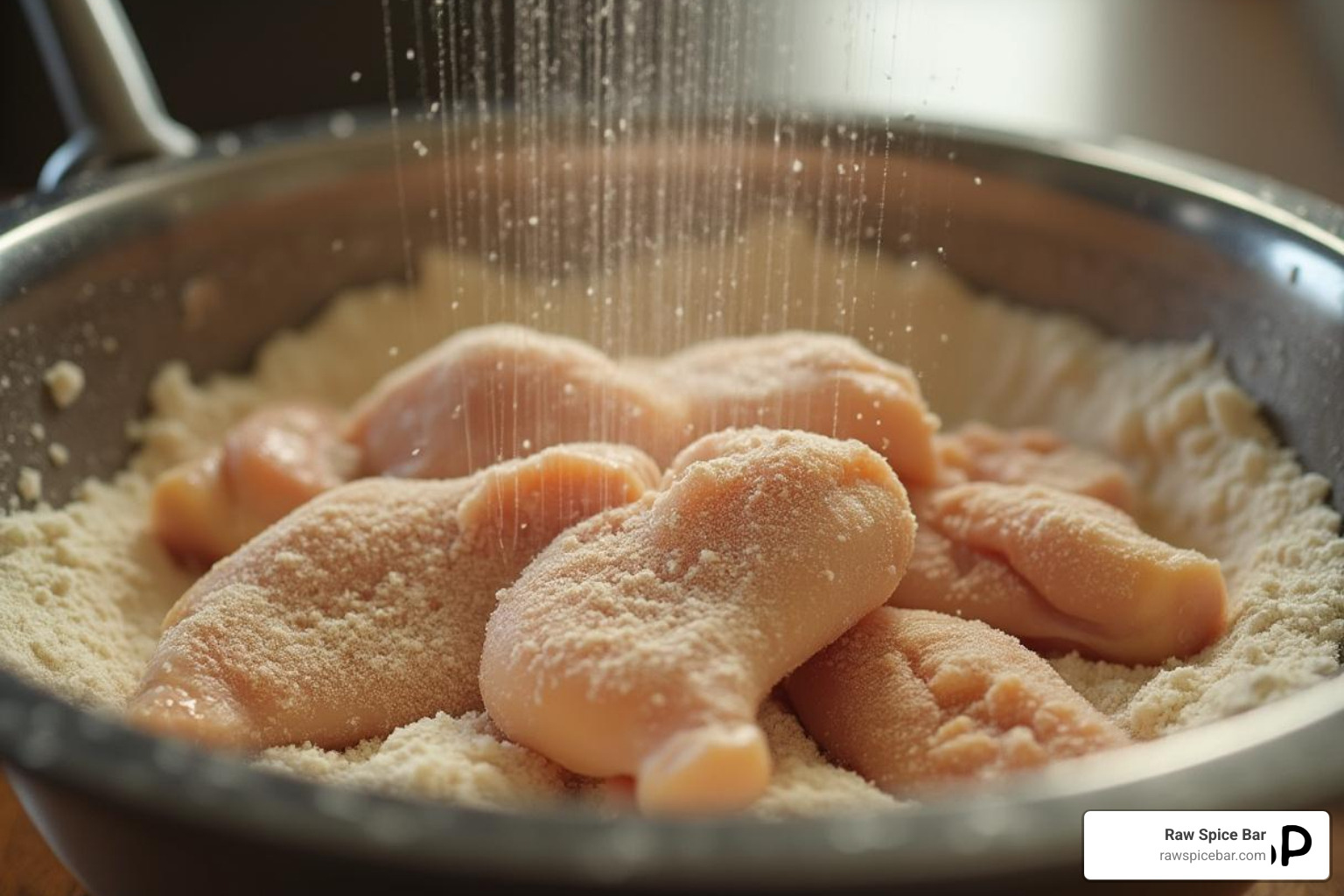
We're creating depth with our poultry seasoning for fried chicken by seasoning the chicken before it ever touches the flour.
Stage 1: Seasoning the Meat and Brine
This is the most important step. Seasoning only the flour gives you a flavorful crust but bland meat. When you season the meat directly, flavors have time to penetrate.
A buttermilk brine is the gold standard. The acids in buttermilk tenderize the meat and carry your poultry seasoning for fried chicken deep into it. Mix your seasoning into the buttermilk and let the chicken soak, preferably overnight.
A pickle juice brine is another effective option, tenderizing the meat while adding a unique tangy flavor.
For a dry brine, combine salt, a touch of sugar, and your poultry seasoning, then massage it all over the chicken. Let it rest in the fridge for at least four hours, but overnight marination yields the most tender, flavorful results.
Generous seasoning and time are key to changing your fried chicken. Best Spices for Marinades and Rubs
Stage 2: Seasoning the Flour Dredge
Now we build the crispy crust. Don't be timid with your seasoning here!
Your seasoned flour should have visible flecks of herbs and spices. Much of this seasoning falls off during frying, so start with an abundant amount.
For the crispy crust secret, add cornstarch to your flour. Replace about a quarter of your all-purpose flour with cornstarch for a crust with a satisfying shatter.
The paper bag method is effective for an even coating. Place seasoned flour and chicken in a large paper bag, close it, and shake well.
After dredging, let the coated pieces rest for 15-20 minutes. This allows the flour to hydrate, creating a coating that adheres better during the cooking process.
How Much Poultry Seasoning for Fried Chicken Should You Use?
The general rule of thumb is to use at least 1 tablespoon per cup of flour as a starting point. Your seasoned flour should be visibly spiced. It's difficult to over-season fried chicken breading because much of the flavor is lost in the oil.
Making bulk seasoning is a time-saver. Mix a large batch of your perfect poultry seasoning for fried chicken blend and store it in an airtight container. You'll always be ready when a craving hits.
This layered approach ensures that even if some breading falls off, your chicken will still be packed with flavor. A detailed Southern Fried Seasoning Recipe
Beyond Traditional Blends: Other Spices to Lift Your Chicken
While classic poultry seasoning for fried chicken is a great start, other spices offer endless possibilities for a spicier kick, deeper savory notes, or a global twist.
Let's explore some exciting options to create your perfect flavor.
Popular Individual Spices and Blends
Many fried chicken recipes get their signature taste from specific spice combinations.
For color and mild flavor, Paprika is a must-have; use Smoked Paprika for a barbecue-like depth. Garlic Powder and Onion Powder are essential for a foundational savory sweetness.
For heat, Cayenne Pepper is easily adjustable. For a unique, earthy warmth common in Southern cooking, try White Pepper. Celery Salt adds a savory, salty note, while Mustard Powder provides a tangy, pungent warmth. For an Asian-inspired kick, Ground Ginger brings a warm, pungent flavor.
Ready-made blends are also great options. Adobo Seasoning brings savory, earthy notes. For a vibrant Louisiana taste, Creole Seasoning is perfect, loaded with paprika, cayenne, and garlic. For a creamy, herbaceous flavor, try Ranch Powder.
Here's a quick comparison of traditional poultry seasoning and a Southern-style blend:
| Spice/Blend | Traditional Poultry Seasoning (Primary Role) | Southern-Style Fried Chicken Blend (Primary Role) |
|---|---|---|
| Sage | Dominant earthy, minty, peppery | Often present, but less dominant |
| Thyme | Earthy, subtle floral | Often present, balanced |
| Marjoram | Mild, sweet, delicate | Less common, or in small amounts |
| Rosemary | Pungent, piney | Less common, or in small amounts |
| Nutmeg | Warm, sweet undertone | Less common, or in small amounts |
| Paprika | Sometimes for color/mild flavor | Essential for color, mild/smoky flavor |
| Garlic Powder | Often included | Essential for savory depth |
| Onion Powder | Often included | Essential for savory depth |
| Cayenne Pepper | Rarely | Common for heat |
| White Pepper | Rarely | Common for earthy heat |
| Celery Salt | Rarely | Common for savory tang |
| Mustard Powder | Rarely | Common for pungent warmth |
| Ground Ginger | Rarely | Sometimes for unique warmth |
| Salt & Black Pepper | Always, foundational | Always, foundational |
Find what you love! Spice Combinations for Chicken Dishes can give you more ideas.
Exploring Global Fried Chicken Flavors
Fried chicken is a global favorite, with many cultures offering unique takes. At Raw Spice Bar, we love celebrating these global flavors.
Japanese Karaage features a light, crispy cornstarch coating. The chicken is marinated in soy sauce, sake, ginger, and garlic for a distinct savory, aromatic taste.
Indian Fried Chicken is marinated in yogurt, ginger-garlic paste, turmeric, chili powder, and garam masala (a warm blend of spices like cumin and coriander). The result is deeply flavorful and often spicy. Recipe for Indian Fried Chicken.
Korean Fried Chicken is famous for its ultra-crispy crust, often from a 100% cornstarch dredge and double-frying. The magic is often in the sweet-spicy glaze made with gochujang (Korean chili paste), soy sauce, garlic, and honey.
These variations show that while traditional poultry seasoning for fried chicken is a great start, the world is full of exciting spices and techniques.
DIY vs. Store-Bought: Crafting Your Own Perfect Blend
When it comes to poultry seasoning for fried chicken, you can use a pre-made blend or craft your own. While store-bought options are convenient, mixing your own blend has serious advantages.
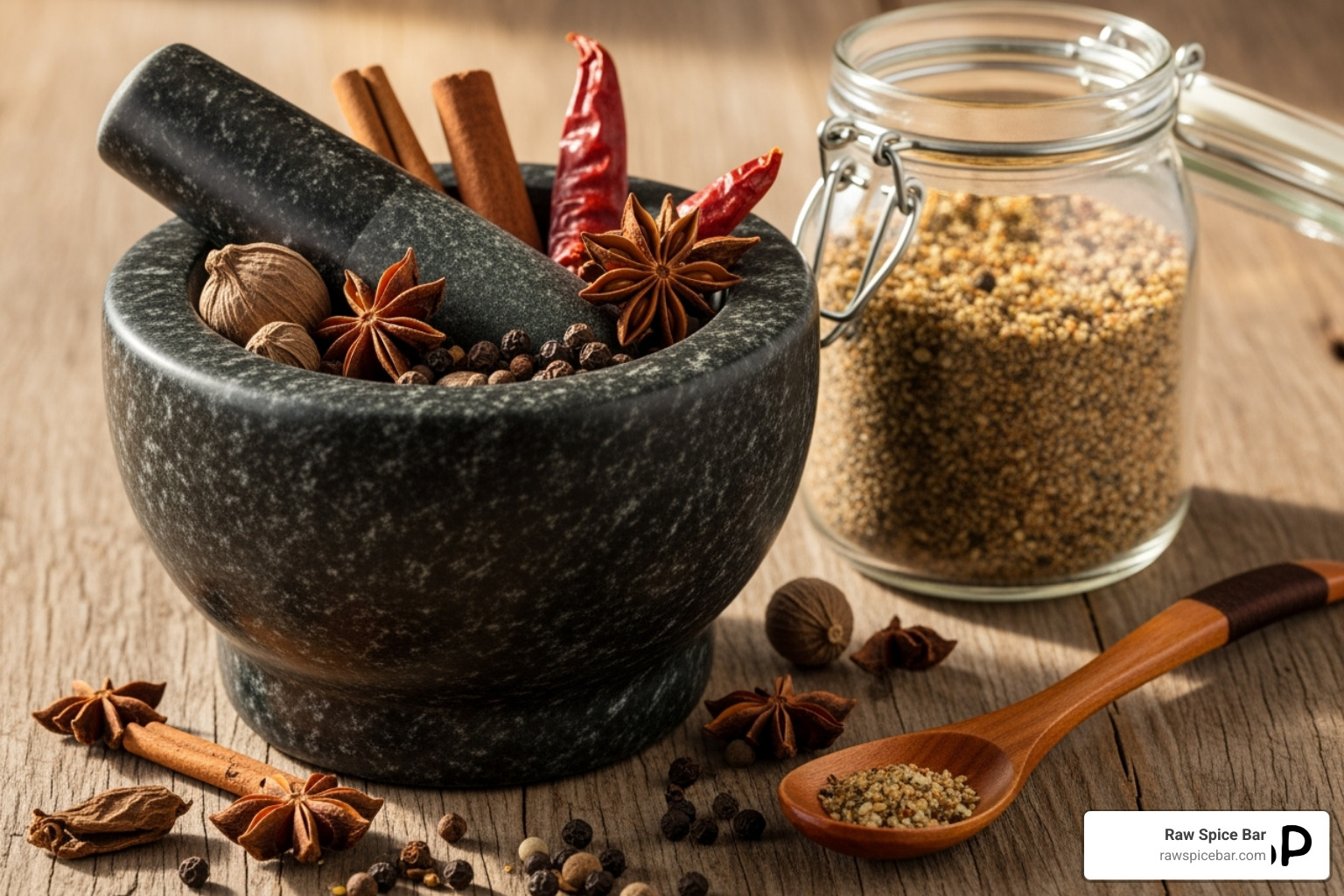
At Raw Spice Bar, we believe in the power of fresh, high-quality spices, which shine when you create something unique.
Advantages of Homemade Seasoning
Making your own spice mix gives you control and freshness that pre-made options can't match.
- Peak Freshness: Spices lose potency over time. Grinding and mixing your own, especially from whole spices, ensures maximum flavor and aroma.
- Customization: Tweak the ratios of herbs and spices to perfectly match your personal taste. Create a signature blend that’s exactly right for you.
- Ingredient Control: Avoid the anti-caking agents, fillers, or additives found in many commercial blends. This is also great for your health, as you can control salt levels precisely. Low Sodium Poultry Seasoning That Doesn't Skimp on Taste.
- Cost-Effective: Buying individual spices in bulk and mixing them yourself often saves money in the long run.
A Simple Homemade Poultry Seasoning Recipe
Ready to create your signature blend? This simple recipe yields about 6 teaspoons.
Ingredients:
- 2 teaspoons dried sage
- 1.5 teaspoons dried thyme
- 1 teaspoon dried marjoram
- 1 teaspoon dried rosemary
- 0.5 teaspoon ground nutmeg
- 0.5 teaspoon finely ground black pepper
Instructions:
- Measure all ingredients into a small bowl.
- Whisk until well combined.
- Optional Additions: To customize your poultry seasoning for fried chicken, consider adding 1 tsp onion powder, 1 tsp garlic powder, or 0.5 tsp paprika. For heat, add a pinch of cayenne pepper. Remember: It's best to add salt separately to your chicken and flour for maximum control.
- Transfer the blend into a small, airtight container.
- Label the container with the name and date.
- Store in a cool, dark place for up to six months for peak freshness.
This recipe is a great starting point. Feel free to experiment and make it your own! How to Blend Your Own Spice Mixes at Home.
Frequently Asked Questions about Seasoning Fried Chicken
Let's tackle the most common questions about making perfect fried chicken.
Should you season the chicken, the flour, or both?
The answer is simple: always season both for the best results. It's the difference between good and incredible fried chicken.
Seasoning the chicken directly (with a brine or dry rub) allows flavor to penetrate deep into the meat. Seasoning the flour creates the delicious, crispy crust we all crave. Be bold with your poultry seasoning for fried chicken in the flour—if you can't see the spice flecks, you haven't used enough.
This double-seasoning approach creates layered flavor, ensuring that even if some breading falls off, the chicken underneath is still delicious.
How do you keep the breading from falling off?
Watching your beautiful coating slide off is frustrating. Here are some tried-and-true techniques:
- Pat the chicken completely dry with paper towels. Moisture is the enemy of adhesion.
- Let it rest. After coating the chicken, let it sit on a wire rack for 15-20 minutes. This helps the flour hydrate and form a sticky paste that adheres better.
- Don't overcrowd the pan. Frying too many pieces at once drops the oil temperature, leading to soggy chicken and a coating that falls off.
- Ensure proper oil temperature. Heat your oil to 350-375°F. The coating will set immediately, creating a protective barrier.
Can I use a poultry seasoning substitute?
Absolutely. If you're out of a pre-made blend, you can easily make a substitute.
A simple mix of sage and thyme works well, as they are the backbone flavors of traditional poultry seasoning.
Italian seasoning can work in a pinch. It contains similar herbs like thyme, rosemary, and marjoram, so the flavor profile will be pleasant, though different.
For the best results, create a custom blend. Start with sage, add thyme and rosemary, then improve it with garlic powder, onion powder, and paprika. A pinch of black pepper and nutmeg will round it out.
Best Poultry Seasoning Substitute has more ideas for working with what's in your spice cabinet.
Conclusion
The secret to unforgettable fried chicken is layering flavor. We've explored how to use poultry seasoning for fried chicken to achieve this, seasoning at every step—from the brine to the flour dredge.
Whether you stick to classic notes of sage and thyme, explore a spicy Southern blend, or dive into global flavors, the possibilities are endless. Crafting your own homemade spice blends offers unparalleled freshness and a chance to make your fried chicken uniquely yours.
The journey to perfect fried chicken is a delicious one. The key to exceptional flavor starts with high-quality, fresh spices. At Raw Spice Bar, we believe in bringing you the best, globally inspired collections to ensure your fried chicken is always crispy, crunchy, and utterly delicious.



